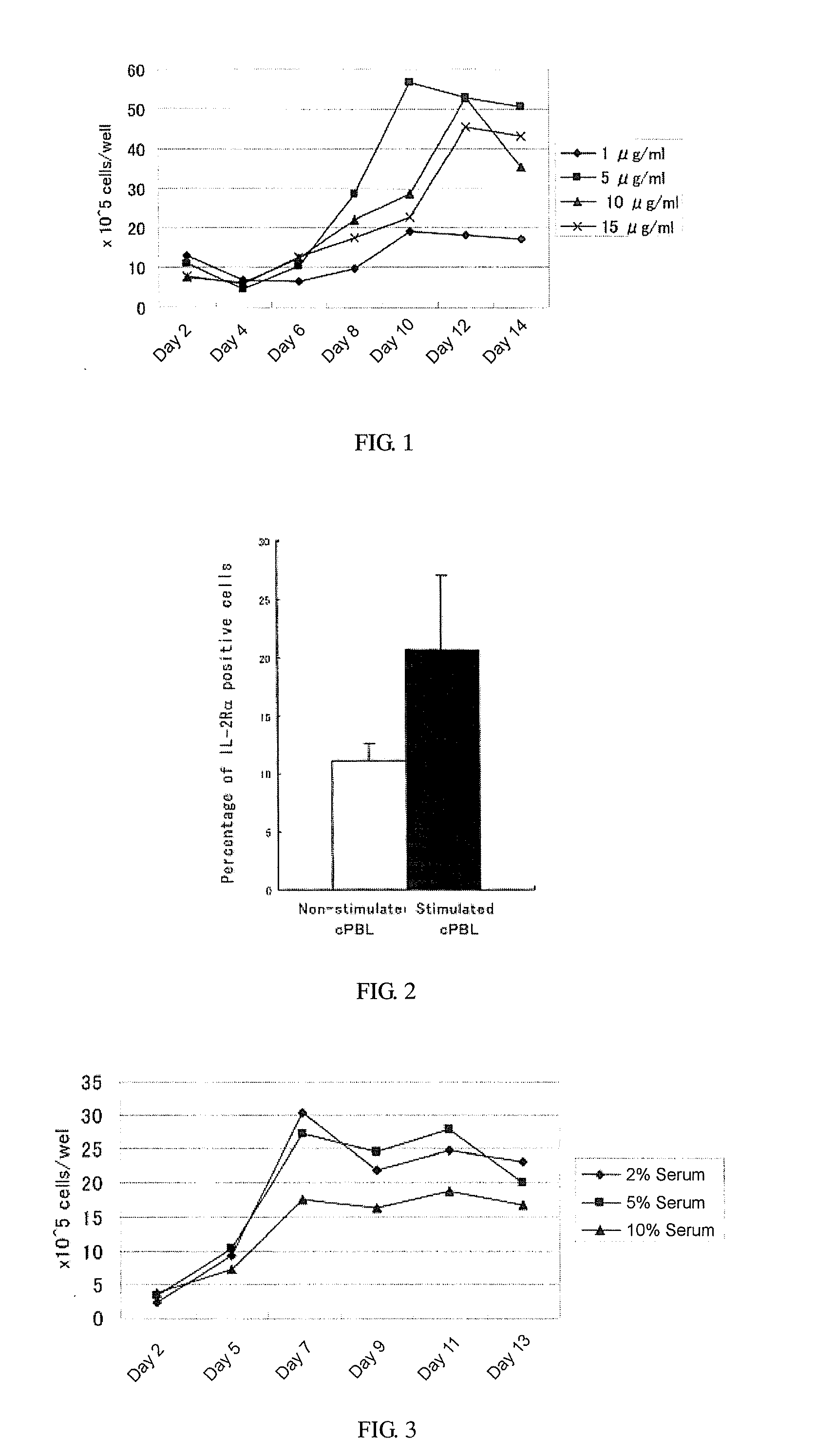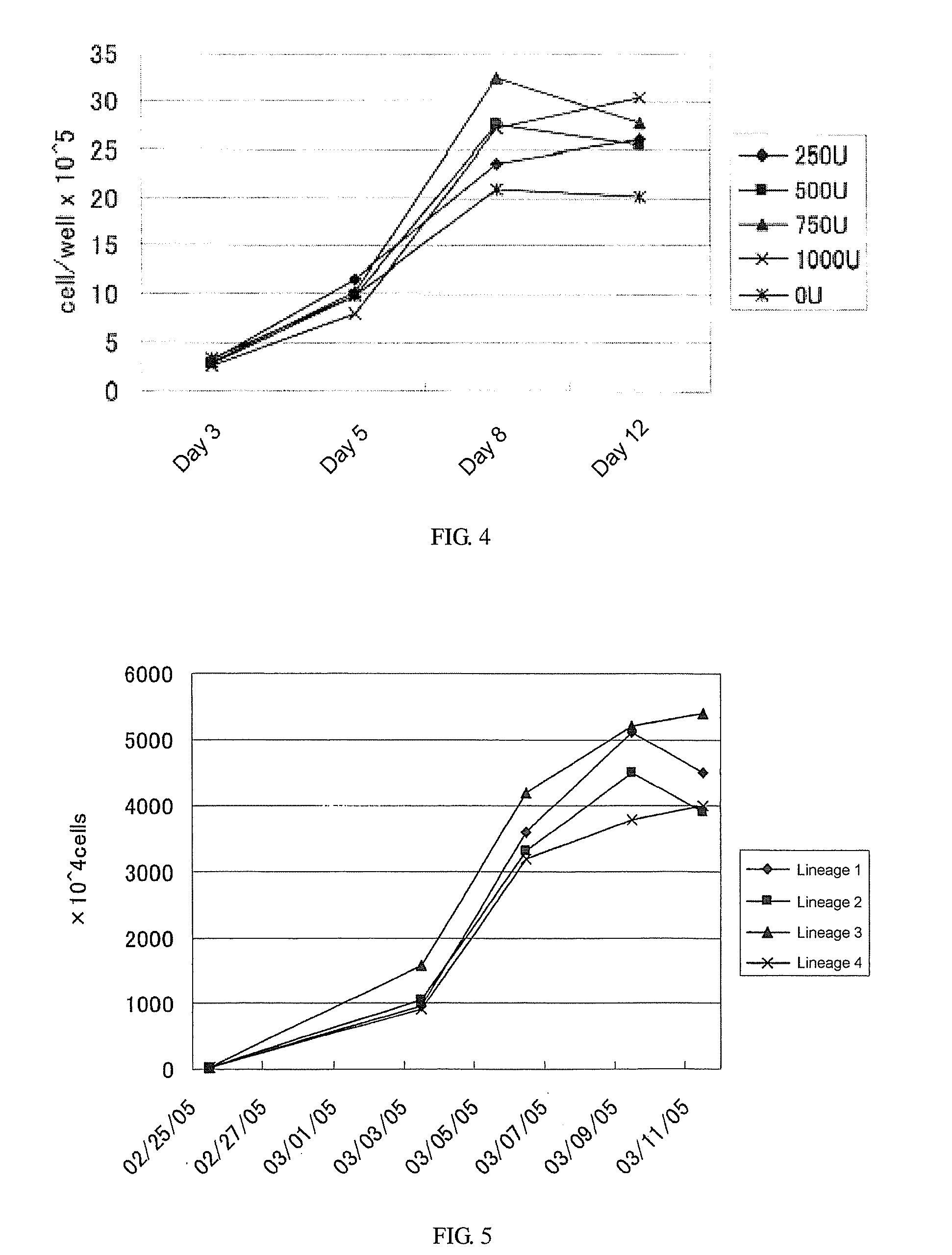Method of proliferating lak cell
a technology of lak cells and proliferating cells, which is applied in the field of proliferating lak cells, can solve the problems of high physical burden and adverse effects, the treatment of lak therapy or ctl therapy is considered difficult to be applied to non-human animals from the economic viewpoint, and the anti-cd3 antibodies, especially the anti-cd3 antibody for a human now generally used in the art, are very expensive. , to achieve the effect of low cos
- Summary
- Abstract
- Description
- Claims
- Application Information
AI Technical Summary
Benefits of technology
Problems solved by technology
Method used
Image
Examples
example 1
[0079]In this Example, an optimum proliferation condition for LAK cells was investigated using concanavalin A as a plant lectin and human interleukin-2 as a growth factor having interleukin-2-like activity.
[0080]1. Optimization of Concanavalin A Concentration
[0081](1) Harvesting of Start Specimen
[0082]The whole blood 30 ml was collected from the cervical vein of beagle (6-year-old), in an injection syringe (blood clotting was inhibited by heparin). Then, the collected whole blood was subjected to centrifugation, one volume of the collected peripheral blood pellet was combined with 10 volume of any of solutions of (a) NH4Cl buffering solution (NH4Cl: 0.83 g / 100 ml of distillated water), (b) Tris base solution (20.6 g / 1000 ml of distillated water, pH7.2), or (c) a filter-sterilized solution of the mixture of the solutions a) and (b) at a ratio of 9:1, and then thus obtained suspension was placed in ice for 5 minutes (sometimes stirring), and red blood cells contained in the whole bloo...
example 2
[0110]The effects of types of serum used in the culture medium on the proliferation of LAK cells were determined using autologous serum, fetal bovine serum, or feline serum. Specifically, the effects were determined by the following procedures.
[0111]1. Use of Autologous Serum
[0112](1) Experimental Procedure
[0113]Through the method similar to that of Example 1, four series of cell suspensions (1 ml each) were collected from 4 dogs (Miniature Pinscher, 2-year-old; mixed-breed, 1-year-old; Pomeranian, 10-year-old; mixed-breed, 3-year-old) (the cell density: 1.5×106 cells / ml). The culture medium was added to thus obtained each series of the cell suspensions to adjust the cell density at 1×105 cells / ml, and 3 ml each of the cell suspensions were poured into each well of 6-well plate (3×105 cells / well), which was supplemented with a final concentration of 5 μg / ml of concanavalin A, a final concentration of 5% of autologous serum, and a final concentration of 750 U / ml of interleukin-2. The...
example 3
[0129]In this Example, the changes in a cellular profile before and after proliferation were determined using a flow cytometer. Specifically, relating to CD8+ cells (which are aβ-type T cells and associated with cell-mediated immunity) and CD4+ cells (which are associated with antibody-mediated immunity), both of which were proliferated by a method for proliferation of the invention, the number of CD8+ cells and CD4+ cells and the ratio thereof were determined by the following procedure.
[0130](1) Experimental Procedure
[0131]Through the method similar to that of Example 1, three series (cases) of cell suspensions (5 ml each) were collected from 3 dogs (6-year-old) (the cell density: 2-4×107 cells / ml). The culture medium was added to thus obtained each series of cell suspensions to adjust the cell density at 1×106 cells / ml. Two ml each of cell suspensions were seeded in each well of 6-well plate (2×106 cells / well) and, then, the cell suspensions were supplemented with a final concentr...
PUM
| Property | Measurement | Unit |
|---|---|---|
| concentration | aaaaa | aaaaa |
| concentration | aaaaa | aaaaa |
| concentration | aaaaa | aaaaa |
Abstract
Description
Claims
Application Information
 Login to View More
Login to View More - R&D
- Intellectual Property
- Life Sciences
- Materials
- Tech Scout
- Unparalleled Data Quality
- Higher Quality Content
- 60% Fewer Hallucinations
Browse by: Latest US Patents, China's latest patents, Technical Efficacy Thesaurus, Application Domain, Technology Topic, Popular Technical Reports.
© 2025 PatSnap. All rights reserved.Legal|Privacy policy|Modern Slavery Act Transparency Statement|Sitemap|About US| Contact US: help@patsnap.com



